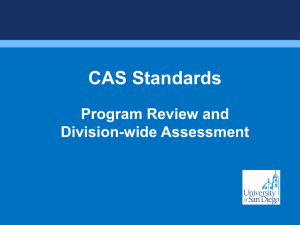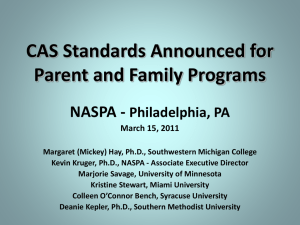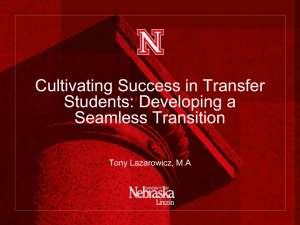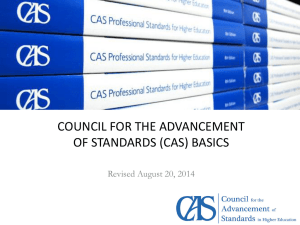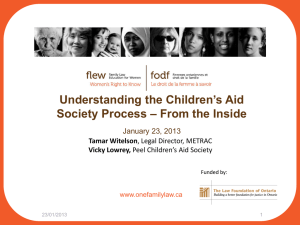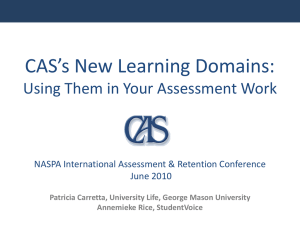Using CAS Learning and Development Outcomes in Transfer
advertisement
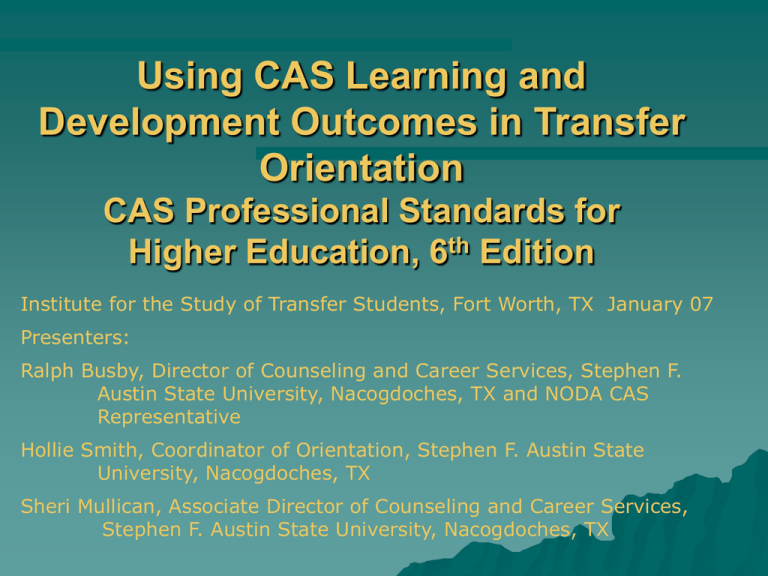
Using CAS Learning and Development Outcomes in Transfer Orientation CAS Professional Standards for Higher Education, 6th Edition Institute for the Study of Transfer Students, Fort Worth, TX January 07 Presenters: Ralph Busby, Director of Counseling and Career Services, Stephen F. Austin State University, Nacogdoches, TX and NODA CAS Representative Hollie Smith, Coordinator of Orientation, Stephen F. Austin State University, Nacogdoches, TX Sheri Mullican, Associate Director of Counseling and Career Services, Stephen F. Austin State University, Nacogdoches, TX CAS Resources CAS Manual Order on line at www.cas.edu CAS Resources • • Self-Assessment Guides are available in CD form or in printed form Guides may be ordered with the manuals or separately FREQUENTLY ASKED QUESTIONS ABOUT CAS (23 Qs) • What is CAS? CAS, the acronym used for the Council for the Advancement of Standards in Higher Education established in 1979, is a consortium of 35 professional associations concerned with the development and promulgation of professional standards and guidelines for student learning and personal development support programs and services in institutions of higher learning. The Council's Board of Directors is composed of representatives from member associations and meets semi-annually in the Spring and the Fall. Prior to 1992, the consortium's name was the Council for the Advancement of Standards for Student Services/Development Programs. FREQUENTLY ASKED QUESTIONS ABOUT CAS • What CAS Standards and Guidelines are currently in place? The 2006 publication of Professional Standards for Higher Education has 34 sets of functional area standards and guidelines and one set of student affairs master's level preparation standards. Functional areas for which standards have been developed include programs and services concerned with: 1. Academic Advising * 2. Admission Programs 3. Alcohol, Tobacco, and Other Drug Programs 4. Campus Activities Programs 5. Campus Information and Visitor Services 6. Campus Religious and Spiritual Programs * 7. Career Services 8. Clinical Health Programs * 9. College Honor Societies * 10. College Unions 11. Commuter and Off-Campus Living Programs * 12. Conference and Events Programs 13. Counseling Services 14. Disability Support Services 15. Distance Education Programs 16. Education Abroad Programs and Services * 17. Financial Aid 18. Fraternity and Sorority Advising Programs Frequently Asked Questions About CAS 19. Health Promotion Programs * 20. Housing and Residential Life Programs * 21. International Student Programs 22. Internship Programs * 23. Learning Assistance Programs 24. Lesbian, Gay, Bisexual, and Transgender Programs 25. Multicultural Student Programs & Services * 26. Orientation Programs * 27. Outcomes Assessment and Program Evaluation 28. Recreational Sports Programs 29. Registrar Programs and Services 30. Service-Learning Programs * 31. Student Conduct Programs * 32. Student Leadership Programs 33. TRIO and Other Educational Opportunity Programs 34. Women Student Programs * 35. Master's Level Student Affairs Administration Preparation Programs FREQUENTLY ASKED QUESTIONS ABOUT CAS • Who uses the CAS Standards and how are they typically put to use? There are a number of uses for the CAS Standards. They include program development, continuous improvement, selfstudy for accreditation or review, staff development, student development, program planning, program evaluation, and education about student affairs services and programs. In addition, CAS has collected a database of professionals and institutions who have used CAS standards in a variety of functional areas. We can provide you with the contact information of persons who have used a particular CAS Standard to assist you with your use of the standards. FREQUENTLY ASKED QUESTIONS ABOUT CAS • What is the difference between a CAS Standard and a CAS Guideline? A CAS Standard, which is printed in BOLD TYPE, is considered to be essential to successful professional practice and uses the auxiliary verbs "must" and "shall." Compliance with the CAS standards indicates that a program meets essential criteria as described in each standard statement and that there is tangible evidence available to support that fact. A CAS Guideline, printed in LIGHT FACE TYPE, is a statement that clarifies or amplifies a CAS standard. Although not required for compliance to be achieved, CAS guidelines are designed to offer suggestions and illustrations that can assist in providing programs and services that more fully address the needs of students than the standard mandates. CAS guidelines provide guidance for exceeding the criteria established by the CAS standards so as to approach excellence or to function at a more optimal level. CAS guidelines use the auxiliary verbs "should" and "may." 13 Areas of Standardization Identified for Orientation Programs • Mission • Program • Leadership • Organization and Management • Human Resources • Financial Resources • Facilities, Technology and Equipment 13 Areas of Standardization Identified for Orientation Programs • Legal Responsibilities • Equity and Access • Campus and External Relations • Diversity • Ethics • Assessment and Evaluation The Mission of Orientation Programs (OP) Must Include: • Facilitating the transition of transfer students into the institution • Preparing transfer students for the institution’s educational opportunities and student responsibilities • Initiating the integration of transfer students into the intellectual, cultural, and social climate of the institution • Supporting parents, partners, guardians, and children of transfer students Learning and Development Outcomes for Orientation Programs for Transfer Students • • • • • • • • • Intellectual Growth Effective Communication Realistic Self-appraisal Enhanced Self-esteem Clarified Values Career Choices Leadership Development Healthy Behavior Meaningful Interpersonal Relationships • • • • • • • Independence Social Responsibility Collaboration Satisfying and Productive Lifestyles Appreciation of Diversity Spiritual Awareness Achievement of Personal and Educational Goals Learning and Development Outcomes for Orientation Programs for Transfer Students • The central idea for learning and development outcomes for Transfer Orientation is: • What is it that a transfer student should know and be able to do as a consequence of attending Transfer Orientation? Intellectual Growth • Develops educational goals • Examines information about academic majors and minors • Understands the requirements of an academic degree plan • Examines the core curriculum • Demonstrates knowledge about internships and volunteer opportunities • Develops personal goals • Makes decisions based on complex information from a variety of sources including personal experience, personal values, and orientation programs Effective Communication • Examines personal and academic strengths and weaknesses which affect academic plans and communicates that information to academic advisors • Demonstrates the ability to use information on academic policy, student support services, and financial services • Demonstrates the ability to use technological resources • Composes appropriate questions when inquiring about particular requirements, departments, and resources • Appropriately introduces oneself and initiates conversations with others Enhanced Self-Esteem • Shows respect for self and others • Demonstrates assertive behavior and evaluates reasonable risks with regard to academic course selection and course load when conferring with academic advisors • Produces a schedule of classes in consultation with orientation staff and/or academic advisors Realistic Self-Appraisal • Evaluates personal and academic skills, abilities, and interests and establishes appropriate educational plans for the first semester • Ranks academic strengths and weaknesses • Focuses on areas of academic ability and interest, and mitigates academic weaknesses • Uses information on course selection, course load, and course schedule in order to construct a schedule • Formulates opportunities for involvement in cocurricular activities Clarified Values • Demonstrates ability to evaluate personal values and beliefs regarding relationships, diversity, substance use, academic integrity, and other ethical issues • Analyzes personal, work, and lifestyle values and explains how they influence decision-making in regard to course selection, course load, and level of personal involvement in the campus community • Acts in congruence with values Career Choices • Describes career choice options of academic major and minor based on interests, skills, abilities, and values • Identifies the purpose and role of Career Services in the development and attainment of academic and career goals Leadership Development • Demonstrates awareness of leadership opportunities, including those in part-time jobs on and off campus, and internships Healthy Behavior • Describes personal behaviors and environments that promote health and reduce risk • Identifies services provided to support the advancement of a healthy lifestyle and a healthy campus community • Articulates the relationship between health and the development of lifelong goals Meaningful Interpersonal Relationships • Creates relationships with fellow students, orientation staff, faculty members, academic advisors, and other institution staff in order to be engaged with the institution in a meaningful way • Demonstrates ability to listen to others’ points of view • Treats others with respect Independence • Operates autonomously by attending prescribed student orientation programs while parents and family are attending different programs simultaneously • Selects, schedules, and registers for academic courses with the advice and counsel of academic advisors and orientation staff • Manages the campus physical environment (i.e., location of buildings, understand a bus schedule) Social Responsibility • Understands the requirements of the codes of conduct • Has knowledge of institution governance systems Collaboration • Works cooperatively with others • Seeks the involvement of others • Seeks feedback from others • Contributes to achievement of a group goal • Exhibits effective listening skills Satisfying and Productive Lifestyles • Determines the balance between academic course load requirements, work, and leisure time • Constructs goals for academic course requirements, work, and leisure time activities • Identifies obstacles that hamper the achievement of stated goals • Decides the importance of functioning on the basis of personal, ethical, spiritual, and moral values Appreciating Diversity • Becomes aware of the impact of culture on individuals • Becomes aware of educational offerings related to diversity • Demonstrates an appreciation for diversity and the impact it has on society • Seeks involvement with people different from oneself • Challenges appropriately the abusive use of stereotypes Spiritual Awareness • Develops and articulates personal belief system • Understands the role of spirituality in personal and group values and behaviors • Identifies campus and community spiritual and religious resources Personal and Educational Goals • Determines personal and academic goals and objectives • Uses personal and academic goals to guide decisions • Considers the effect of one’s personal and academic goals on parents, family, and others Transfer Orientation Program Standards Must: • Be based on stated goals and objectives • Be coordinated with the relevant programs and activities of other institutional units • Be available to all transfers new to the institution, as well as to families • Assist transfer students as well as their families in understanding the purposes of higher education and the mission of the institution Transfer Orientation Program Standards Must: • Articulate the institution’s expectations of transfers (e.g., scholarship, integrity, conduct, financial obligations, ethical use of technology) and provide information that clearly identifies relevant administrative policies and procedures and programs to enable transfers to make well-reasoned and wellinformed choices • Provide transfer students with information and opportunities for academic and personal selfassessment • Use qualified faculty members, staff, or peer advisors to explain class scheduling, registration processes, and campus life Transfer Orientation Program Standards Must: • Provide transfer students as well as their families, with information about laws and policies regarding educational records and other protected information • Inform transfer students as well as their families about the availability of services and programs • Assist transfer students as well as their families in becoming familiar with the campus and local environment Transfer Orientation Program Standards Must: • Assist transfer students, as well as their families in becoming familiar with the wide range of electronic and information resources available and expectations for their use • Provide time for transfers to become acquainted with their new environment • Provide intentional opportunities for transfer students to interact with fellow transfer students as well as continuing students, faculty and staff members Conducting Self-Assessment for Transfer Orientation Programs • ”Self-Assessment Guides” (SAGs) are provided by CAS as companion instruments • SAGs outline the processes to be used for conducting Orientation Programs self-assessment Transfer Orientation Program Self-Assessment Steps (1 – 5) 1. Establish and prepare the self-assessment team Teams should be assembled from student services, academia, and student orientation staff. Not everyone will have the same background, experience and opinions and THAT IS OK!!!! Transfer Orientation Program Self-Assessment Steps 2. Understand the CAS Standards and Guidelines If you do not know what ‘best practices’ are, it will be difficult to know how a program measures up. 3. Compile and Review Documentary Evidence Transfer recruitment material Transfer Orientation programs Institutional administrative documents Research, assessment and evaluation data Staff activity reports Student activity reports Transfer Orientation Program Self-Assessment Steps 4. Judging performance Five point rating scale, 1-5 (5 is fully compliant). Information Not Available should also be used. Exemplary ratings should be reserved for those areas that are clearly above and beyond CAS Standards. Transfer Orientation Program Self-Assessment Steps 5. Implementing the Assessment Process: Use individual rating processes and group rating processes. Once the entire assessment is completed, it is time to move to prepare a Plan of Action to become fully compliant with CAS Standards. Questions? Evaluations Contact Presenters: Ralph Busby, rbusby@sfasu.edu Hollie Gammel Smith, gammelholli@sfasu.edu Sheri Mullican, smullican@sfasu.edu

